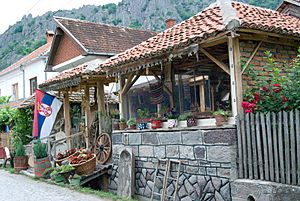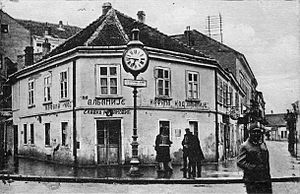Kafana facts for kids

A Kafana is a special kind of local restaurant or cafe found in countries that were once part of Yugoslavia, like Serbia, Croatia, and North Macedonia, as well as in Albania. These places are known for serving coffee and small meals. Many kafanas also have live music, making them lively spots for people to gather.
The idea for these social places, where men could meet and drink coffee, began in the Ottoman Empire. As the Ottomans ruled parts of the Balkans, this tradition spread. Over time, these coffeehouses changed and became the modern kafanas we know today.
What's in a Name?
The word 'kafana' comes from the Turkish word kahvehane, which means "coffeehouse". This Turkish word itself comes from older Persian and Arabic words for "coffee" and "house".
You'll find different names for kafanas depending on the country:
- In Serbian and Bosnian, it's kafana.
- In Croatian, it's kavana.
- In Macedonian, it's kafeana.
- In Albanian, it's kafeneja or kafenë.
- In Greek, it's kafenio.
- In Romanian, it's cafenea.
Sometimes in North Macedonia, people might use kafeana to mean a traditional tavern, while kafana might refer to the type of place described here. However, many people use both words to mean the same thing.
Today in Serbia, the word kafana often means any informal restaurant. These places usually serve traditional local food. They might also offer special kafana dishes, like Karađorđeva šnicla.
A Look Back in Time
In the 1700s and early 1800s, running a kafana was often a family business. It was passed down from parents to children. Back then, these places were sometimes called mehana.
As cities in the Balkans grew bigger and more modern, kafanas also changed. To attract more customers, some started serving food. They also began offering other services because there were more similar places competing for visitors.
Most larger towns and cities had a special place called a Gradska kafana, which means "City kafana". This was usually in or near the main town square. The city's wealthiest and most important people would go there to see and be seen. Because of its great location, prices at the Gradska kafana were usually higher than other places.
Live music became popular in kafanas in the early 1900s. Owners wanted to offer more entertainment to their guests. Since there was no mass media like radio or TV, these bands were local. They mostly played folk music that was popular in their region.
After World War II, many people from the countryside moved to Balkan cities. This led to more changes for kafanas. Some continued to serve upper-class customers. Others started to change to better suit the new city residents. These new residents often worked in factories and on construction sites.
Images for kids







